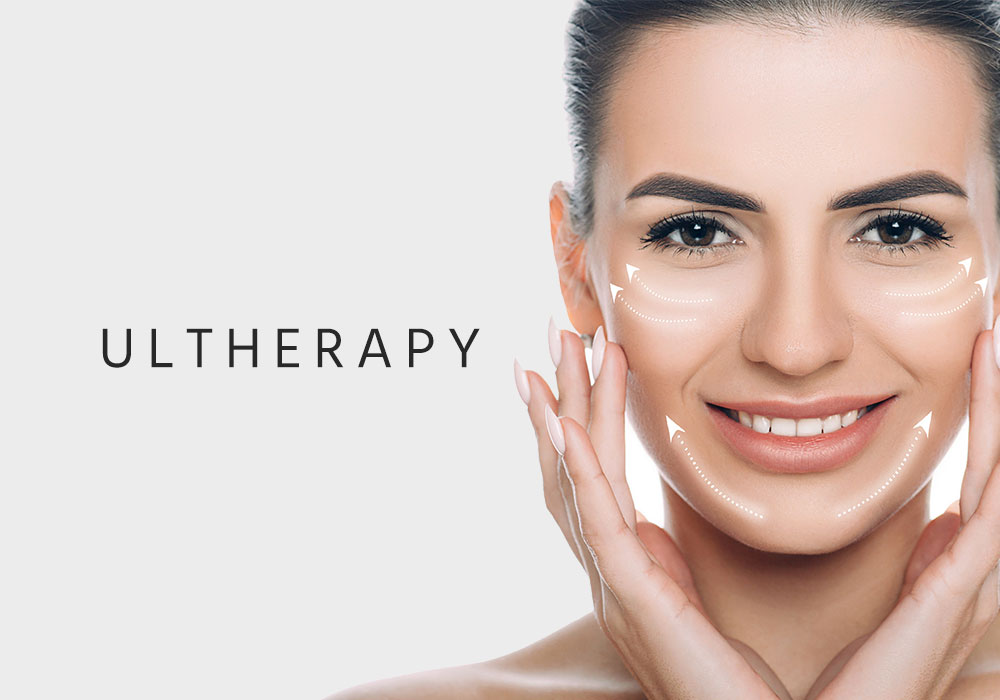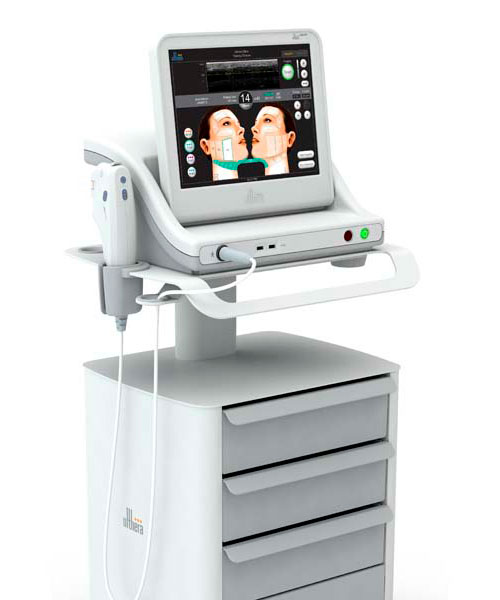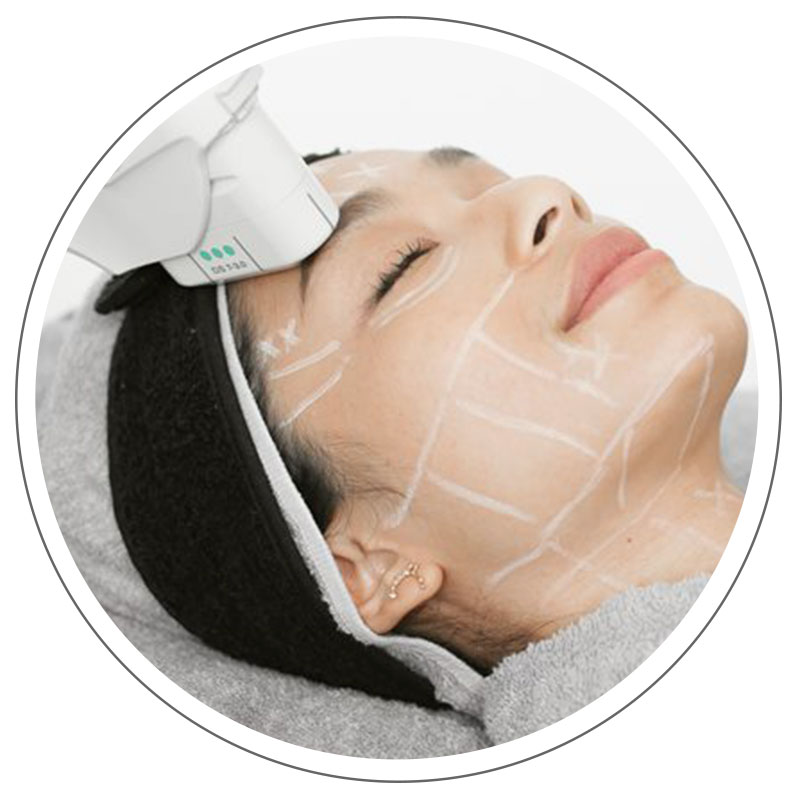


What Is Ultherapy
Ultherapy relies on ultrasound therapy to go deeper than other non-invasive treatments for collagen stimulation. And it leverages traditional ultrasound imaging so Ultherapy providers can see the layers of tissue they are treating. This ensures the treatment energy is delivered to where it benefits you most.Only Ultherapy is FDA-cleared to non-invasively lift skin on the neck, under the chin, and on the brow—and also improve lines and wrinkles on the décolletage! No wonder we’ve delivered more than a million treatments worldwide.
For those who are not ready for a surgical facelift, Ultherapy provides proven results in a single treatment for most patients. Learn how to treat your loose skin without surgery, without impacting the surface of your skin, and without downtime.
How It Works
As a natural protein, collagen works to give skin its youthfulness by keeping it firm and toned. As we age, collagen breaks down, and the result is a loss of skin strength and elasticity. That’s where Ultherapy steps in and lifts up, through ultrasound therapy.Unlike lasers, radio frequency, surgery, and other technologies, nonsurgical Ultherapy bypasses the surface of the skin through ultrasound energy with focused imaging—to target just the right amount at the right depths and the right temperature. The result is a jumpstart to your body’s own collagen production.
The proven results of Ultherapy are clear, appearing over two to three months as new collagen works to lift skin on the neck, chin, and brow—as well as smooth skin on the upper chest. Results may improve over the following three to six months, and can last a year or more.* It won’t duplicate the results of a surgical facelift, but Ultherapy is a clinically proven non-invasive alternative for those not ready for surgery.


How It Works
As a natural protein, collagen works to give skin its youthfulness by keeping it firm and toned. As we age, collagen breaks down, and the result is a loss of skin strength and elasticity. That’s where Ultherapy steps in and lifts up, through ultrasound therapy.Unlike lasers, radio frequency, surgery, and other technologies, nonsurgical Ultherapy bypasses the surface of the skin through ultrasound energy with focused imaging—to target just the right amount at the right depths and the right temperature. The result is a jumpstart to your body’s own collagen production.
The proven results of Ultherapy are clear, appearing over two to three months as new collagen works to lift skin on the neck, chin, and brow—as well as smooth skin on the upper chest. Results may improve over the following three to six months, and can last a year or more.* It won’t duplicate the results of a surgical facelift, but Ultherapy is a clinically proven non-invasive alternative for those not ready for surgery.
FAQs for Ultherapy
1. What is Ultherapy?
Ultherapy is a non-invasive cosmetic procedure that uses focused ultrasound energy to lift and tighten the skin on the face, neck, and décolletage. It stimulates the body's natural collagen production to improve skin firmness and elasticity.
2. How does Ultherapy work?
Ultherapy uses ultrasound energy to target the deep layers of the skin and the foundational layers that are typically addressed in surgical facelifts. The ultrasound energy heats the tissue, stimulating collagen production and resulting in a natural lifting and tightening effect over time.
3. What areas can be treated with Ultherapy?
- Face (brow, cheeks, jawline)
- Neck
- Décolletage (upper chest)
- Under the chin
4. Is Ultherapy safe?
Yes, Ultherapy is an FDA-cleared procedure that has been used safely in over a million treatments worldwide. It utilizes ultrasound imaging, which allows practitioners to see the layers of tissue they are treating, ensuring precise and effective treatment.
5. What can I expect during the treatment?
During the treatment, the practitioner will cleanse the skin and apply an ultrasound gel. The Ultherapy device is then used to deliver focused ultrasound energy to the targeted areas. You may feel a warming or tingling sensation as the energy is delivered. The procedure typically takes 30 to 90 minutes, depending on the area being treated.
6. Is there any downtime after the procedure?
Ultherapy has minimal to no downtime. You may experience slight redness, swelling, or tenderness in the treated areas immediately after the procedure, but these effects usually subside within a few hours to a day. Most patients can return to their normal activities immediately.
7. How many treatments are needed?
Many patients see noticeable results after a single treatment. However, depending on individual skin conditions and goals, additional treatments may be recommended. The results of Ultherapy can last for a year or more as it stimulates ongoing collagen production.
8. When will I see results?
Some patients notice immediate improvements, but the full effects develop gradually over 2 to 3 months as new collagen is produced and existing collagen is remodeled. The results can continue to improve for up to 6 months post-treatment.
9. Are there any side effects?
Side effects are generally mild and temporary, including redness, swelling, tenderness, bruising, or a slight tingling sensation. These typically resolve within a few hours to a day. Rarely, more severe side effects such as nerve injury or skin burns can occur.
10. Can Ultherapy be combined with other treatments?
Yes, Ultherapy can be combined with other cosmetic treatments, such as Botox, dermal fillers, and laser resurfacing, to enhance overall results. It's best to consult with your practitioner to develop a personalized treatment plan.
11. Who is a good candidate for Ultherapy?
Good candidates for Ultherapy are individuals with mild to moderate skin laxity and sagging who are looking for a non-invasive treatment option. It is suitable for most skin types and tones. A consultation with a qualified practitioner is necessary to determine the appropriateness based on individual skin conditions and goals.
12. How do I prepare for an Ultherapy treatment?
Preparation typically involves:
- Avoiding sun exposure and tanning for a few weeks before the procedure.
- Stopping the use of certain skincare products, like retinoids, for a few days before the treatment.
- Following any specific instructions provided by your practitioner.
13. How do I care for my skin after the treatment?
Post-treatment care involves:
- Keeping the skin clean and hydrated.
- Avoiding direct sun exposure and using a broad-spectrum sunscreen.
- Using gentle skincare products.
- Following any specific aftercare instructions provided by your practitioner.
For personalized advice and to determine if Ultherapy is right for you, it's best to consult with a qualified dermatologist or aesthetic professional.


